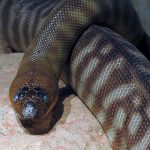WOMA PYTHON
Woma Python
The woma python, scientifically known as Aspidites ramsayi, is a remarkable non-venomous snake native to Australia. Renowned for its distinctive appearance and unique behaviours, the woma python offers a fascinating glimpse into the adaptability of desert-dwelling reptiles.
Physical Characteristics
Adult woma pythons typically measure around 1.5 metres in length, though some individuals can grow up to 2.7 metres. Their bodies are broad and flat, tapering to a slender tail. The coloration varies from pale brown to nearly black, with patterns of medium brown, olive, orange, pink, or red, overlaid with darker striped or brindled markings. The underbelly is cream or light yellow with brown and pink blotches. Notably, woma pythons lack the heat-sensing pits found in other pythons, a feature attributed to their diet primarily consisting of other reptiles.
Habitat and Distribution
Woma pythons inhabit arid and semi-arid regions across central and western Australia, including areas from Western Australia through the Northern Territory, South Australia, Queensland, and New South Wales. They favour sandy soils, which facilitate burrowing, and are often found in shrublands, woodlands, and grasslands. During the day, they shelter in hollow logs, animal burrows, or thick vegetation, emerging at night to hunt.
Behaviour and Diet
As nocturnal hunters, woma pythons primarily prey on small mammals, ground birds, and other reptiles. They employ a unique hunting strategy by wiggling the tip of their slender tail to lure prey close, while the rest of their body remains motionless. Once the prey is within reach, the woma strikes, subduing it by constriction or, in confined spaces like burrows, by pinning it against the walls. This method often results in scars on the woma’s body from retaliatory bites.
Reproduction
Breeding occurs between May and August. Females lay a clutch of 5 to 19 eggs in their burrow, where they incubate them by coiling around the clutch for approximately two months. If the eggs become cold, the female will ‘shiver’ to generate heat from muscular activity to warm the clutch. Upon hatching, the young are independent and receive no further parental care.
Lifespan
In the wild, woma pythons can live up to 15 years, while in captivity, they may reach up to 20 years. (fwzoo.com)
Conservation Status
The woma python is classified as ‘Least Concern’ on the IUCN Red List. However, certain populations, particularly in southwestern Australia, have become critically endangered due to habitat loss from agricultural development and predation by introduced species like foxes and cats. Conservation efforts, including captive breeding programs, aim to protect and restore these populations.
Cultural Significance
In the cultural narratives of the Aṉangu people, the woma python is known as ‘Kuniya’ and holds significant importance as a creation ancestor. The story of Kuniya and Liru is a major Tjukurpa (law and culture) story, reflecting the deep connection between the Aṉangu people and the woma python.
Interesting Facts
Tail Luring: The woma’s slender tail serves as a lure to attract prey, a unique adaptation among pythons.
Burrowing Behaviour: They are adept burrowers, often enlarging existing burrows using their head to dig, which is particularly useful in sandy soils.
Dietary Adaptations: Woma pythons are immune to the venom of other snakes, allowing them to prey on venomous species without harm.
The woma python exemplifies the resilience and adaptability of Australian wildlife, thriving in some of the harshest environments on the continent. Its unique behaviours and ecological role highlight the intricate balance of desert ecosystems and the importance of preserving these remarkable creatures.

